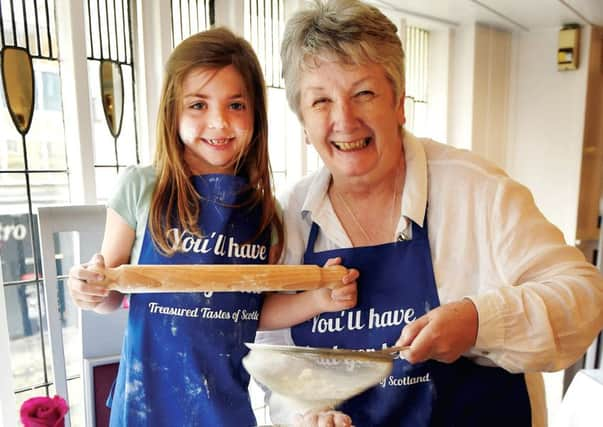How to make Scotland a Good Food Nation


Shirley Spear, of the celebrated Three Chimneys restaurant on Skye, said health, sustainability and prosperity were the three pillars on which a Good Food Nation would be built. She stressed prosperity was not just about wealth, but also social justice and fairness.
Spear saw her role as chair of the commission, established this year, as “the captain of a brand new ship”. She added: “We are all on the journey together; some have more skills and some have more needs.”
Advertisement
Hide AdAdvertisement
Hide AdSpear had been proud to use “wonderful, fresh, seasonal Scottish produce” in her own business, but continued: “I am aware many Scots take so little interest in their food and there are painful medical statistics to face up to. Why, when we produce such delicious food, do we have such a poor health record?
“If we eat better and demand better-quality food, our health and our well-being will improve. Being a Good Food Nation is about pride [in our food] but it’s about much more than window-dressing if we want to make an immeasurable difference.”
The commission has 16 members from a wide cross-section of Scotland’s food and drink sector and reports directly to Cabinet Secretary Richard Lochhead. Its vision is to achieve a range of objectives by 2025, including:
● Making it “normal” for Scots to be interested in good food and to seek it out when they can
● Having schools, hospitals, retailers, canteens, cafes and restaurants committed to serving and selling good food
● Ensuring everyone in Scotland has access to healthy, nutritious food
● Seeing evidence of decline in dietary-related disease and the environmental impact of food consumption
● Making Scottish products increasingly healthy and environmentally sound
Advertisement
Hide AdAdvertisement
Hide Ad● Food companies are thriving and seen as places people want to work
● Seeing other countries looking to Scotland to learn how to be a Good Food Nation.
Spear insisted the commission had to be inclusive and would not be about “finger-wagging dietary advice”. She continued: “This is not Richard Lochhead’s baby, or mine, it’s all of us – every government department, local authority and enterprise agency, every school, hospital and care home, every college and university, every business, every person of every age. It might take a generation to make change for the better, but join and make it happen.”
Lochhead himself was upbeat about the sector and its “phenomenal performance” in recent years: “The world wants what we produce. Our food and drink sector has a competitive advantage and we need to make the most of it. We are very good at producing quality premium products for discerning consumers.
“But Scotland’s health record is a big challenge and we need to create a culture where people enjoy good food –and to remember food and drink isn’t about just exports and good statistics, but also people’s well-being.”
James Withers, chief executive of Scotland Food & Drink, picked up the theme, saying: “We really have to nail our relationship with food and drink if we are going to be the Land of Food and Drink. I think we lost a generation who had no food and drink education but it’s changing for the better – I think my kids have more in a day than I had in 13 years at school.”
Withers said Scotland was clearly doing something right, at home and abroad, which was reflected in much higher manufacturing growth in food and drink than the rest of the UK
Graham Blair of Bank of Scotland also highlighted the positive future for the sector with 14,000 new jobs predicted within the next five years in the Bank’s recent report.
Advertisement
Hide AdAdvertisement
Hide AdHe stressed that challenges lay ahead – including rising costs, regulation and compliance and the potential of an European Union exit – but also the very significant opportunities, including capitalising on provenance, greater collaboration, export potential, product development and research and development.
Withers highlighted collaboration too, suggesting Scotland could “stitch our sectors together”, with food and drink working with, for example, tourism and textiles, to sell a whole package to a hotel in China – a country where there were huge opportunities for Scotland to grow and a “big plan” in place to get specialists on the ground.
The authenticity of our food was crucial, said Withers, highlighting a trend to Far East labelling which stressed products were not made in China. “That’s a real challenge for China, but good for us,” he said.
He thought the export of food technology might be a big new growth area, but warned the Scottish food and drink industry “was not even close to being at the races” when it came to e-commerce and had to improve, especially when $626 billion of goods will be bought from mobile devices alone by 2018.
Withers said the domestic market was going through huge changes, with the 0.2 per cent contraction in the grocery market in 2014, the challenge of Lidl and Aldi to the “big four” and a shift to “promiscuous” shopping, away from a major weekly supermarket visit.
This was one of three growing areas in retail, including the rise of convenience stores and online shopping, Withers noted.
In addition, one in nine meals was now eaten outside the home, but the sector had to shift its thinking because just as many people were having their breakfast out as dinner. “It’s as much about porridge on the go as fine dining,” Withers said.